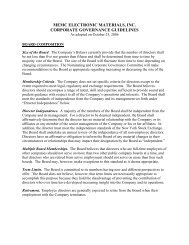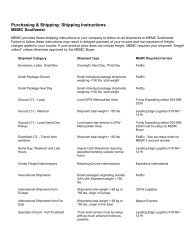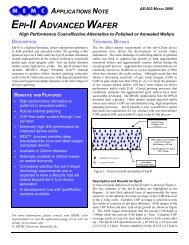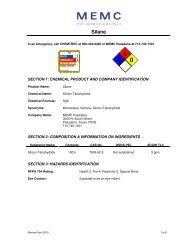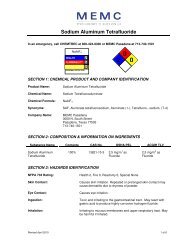BUILDING ON THE PAST, READY FOR THE FUTURE: - MEMC
BUILDING ON THE PAST, READY FOR THE FUTURE: - MEMC
BUILDING ON THE PAST, READY FOR THE FUTURE: - MEMC
Create successful ePaper yourself
Turn your PDF publications into a flip-book with our unique Google optimized e-Paper software.
Up to this point, Dr. Walsh<br />
recalled, Monsanto hadn’t shown<br />
any interest in selling polished<br />
wafers. “Everybody was trying<br />
to make perfect surfaces. When<br />
IBM got our wafers, they became<br />
very interested because they<br />
had their own internal material<br />
department and they couldn’t<br />
make those perfect surfaces,” he<br />
recalled. In fact, IBM managed to<br />
purchase the license for chemicalmechanical<br />
polishing, trading<br />
some patents with Monsanto as<br />
part of the deal. Within the next<br />
couple of years, sales of polished<br />
wafers greatly increased.<br />
ePItaxIal layers<br />
By 1964, 1” wafers went<br />
into commercial production<br />
at St. Peters and shortly<br />
thereafter were replaced by<br />
1.5” wafers. Then, in 1966,<br />
the first epi reactors were<br />
built and installed, giving<br />
<strong>MEMC</strong> the ability to produce<br />
a wafer with a superior<br />
surface. In epi, a thin layer<br />
of silicon is grown on top of<br />
the polished slice surface by<br />
heating it to a temperature of<br />
approximately 2000 degrees<br />
Fahrenheit (approximately<br />
1100 Celsius) in a quartz<br />
chamber filled with hydrogen gas. Another gas<br />
containing silicon in combination with chlorine<br />
and hydrogen is introduced into the quartz<br />
chamber. The silicon layer grown in this manner<br />
is more perfect than the polished slice, having<br />
fewer defects and fewer impurities.<br />
The ability to produce wafers with an epitaxial layer<br />
Silicon brochure.<br />
increased in significance as device manufacturers<br />
required increasingly cleaner and flatter surfaces.<br />
Dr. Graham Fisher described the development<br />
of epi as “a platform improvement” saying, “In<br />
about 1984, <strong>MEMC</strong> was the first to commercialize<br />
epitaxial layers for CMOS technology. In its<br />
<strong>MEMC</strong>’s Pioneering Years 21



